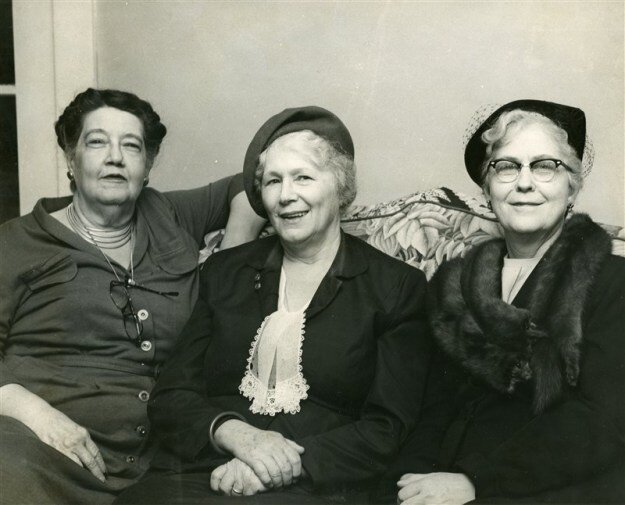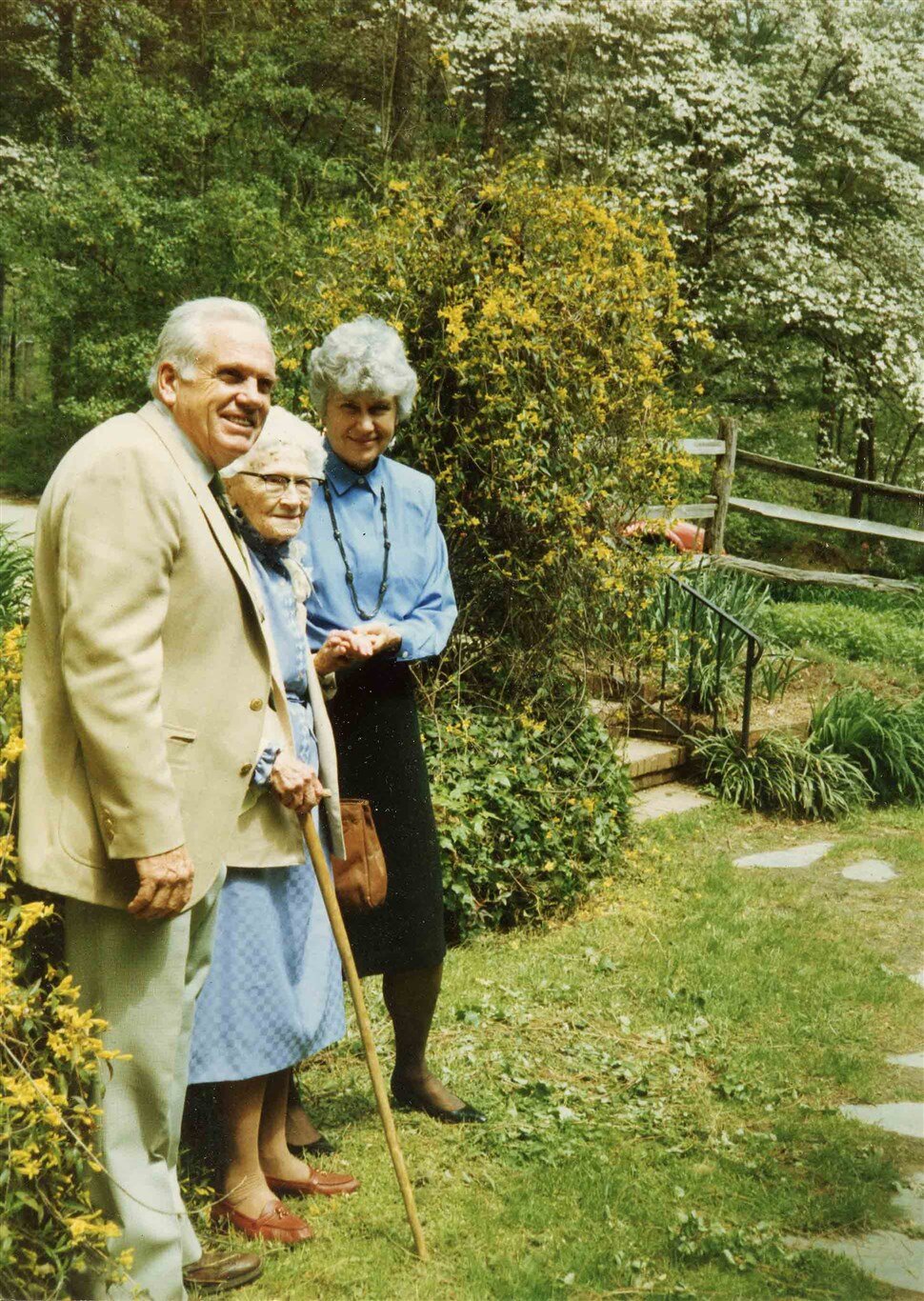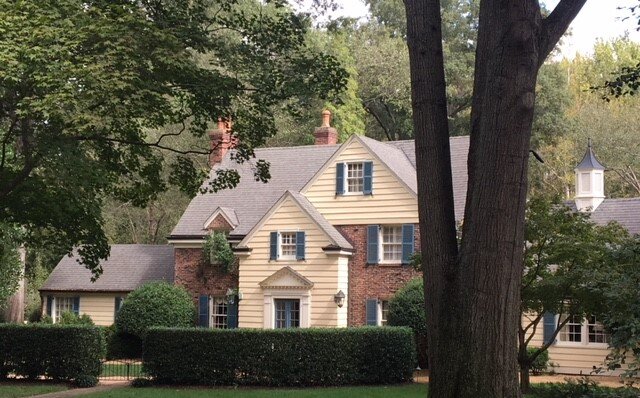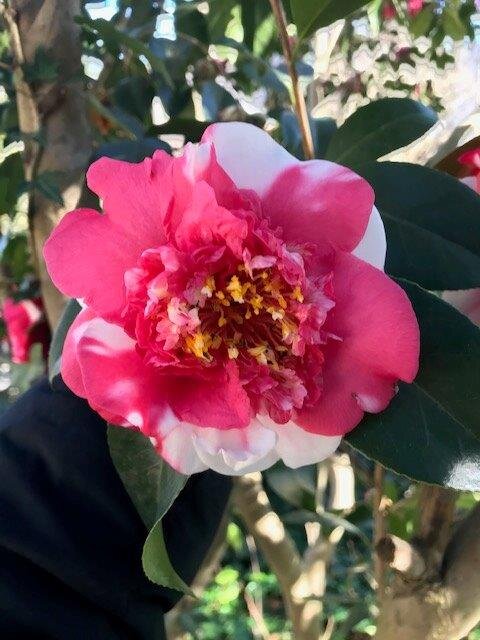by Laurie McDowell
But the night is fair,
And everywhere
A warm, soft vapor fills the air,
And distant sounds seem near,
And above, in the light
Of the star-lit night,
Swift birds of passage wing their flight
Through the dewy atmosphere.
-Birds of Passage by Henry Wadsworth Longfellow
Thus begins Charlotte Hilton Green’s unpublished book, “Bird Sanctuaries,” which she began writing while living on White Oak Road in Raleigh. Charlotte had published columns in the local Raleigh newspapers and frequently began her writing with a poem to get the reader in the mood.
By now, I hope everyone has heard Charlotte Hilton Green and her little park, which we have adopted through the Parks Department. Charlotte was one of Raleigh’s earliest conservationists, an avid birder, and author of two published books in addition to a weekly newspaper column dedicated to gardening and gardens. An integral member of RGC, she gave educational bird talks and organized trips for the club to visit gardens in neighboring communities and states. In 1984, neighbors in Charlotte’s White Oak Road neighborhood worked together to arrange for the City of Raleigh to purchase three lots to preserve as the Charlotte Hilton Green park.
When Charlotte Hilton Green moved to Raleigh from upstate New York in 1920, she probably had no idea what she was getting into. She and her husband Ralph Waldo Green, probably took the train south (she writes of purchasing a car after their arrival in town). Raleigh was a city of 24,000 people, and the city boundaries were approximately East, South, West and North Streets (the “center” of today’s downtown). A trolly car took passengers past the populated areas along Glenwood Avenue up to Bloomsbury (present day Hayes-Barton) for picnics and adventures in the amusement park. My own neighborhood of Five Points was a treeless plain, formerly tobacco, cotton and corn fields, and only recently subdivided into lots for housing. Hayes Barton Baptist Church wouldn’t appear on the scene for another six years. Cameron Park was the brand new fashionable neighborhood.
Once arrived in Raleigh, the couple threw themselves into their new lives. They had met at the Chautauqua Institute in 1913, where Charlotte was attending a course in nature study taught by Ruby Green Smith, Ralph’s sister. The “nature study” movement began at Cornell in the early 1900’s and Ralph’s family was “tied up with it,” according to Charlotte. An educator herself, she had already been teaching her students about birds and nature, using the scenery outside her classroom window to interest and educate her students.
The couple married in 1917 and moved to Raleigh midyear 1920. Ralph worked for the North Carolina Department of Agriculture and later was on the faculty at State College (now NCSU). Charlotte immediately jumped into the Raleigh community, founding the NC State College Woman’s Club with 25 other women. Charlotte and Ralph also met others who would be instrumental in the nature and conservation movements, including B.W. Wells, and brothers C.S. and H. H. Brimley, who would start the state bird club.
In 1923, the Greens built a home on White Oak Road near Crabtree Creek. The Greens had purchased a large tract of land along White Oak, extending from present day Rothgreb Road to St. Mary’s Street. Developers busy with Hayes Barton and Five Points had eschewed the property, thinking that no one would ever want to live that far away from town.
Charlotte and Ralph had “dreamed of a real Bird Sanctuary—and of a small arboretum where we could collect native plants and trees,” Charlotte wrote. The land had been alternately farmed all the way to Crabtree Creek and used as a dump-literally, when there was no municipal trash pickup in the neighborhood. After World War 1, the land was no longer needed for planting and had “gone back to wilderness...Weed trees, brush, tangles..” and the city used dirt alongside the road to fill in potholes on other roads. The Greens began improving their property (with the help of B. W. Wells) by putting up bird boxes, bird baths and feeding stations, and planting vegetation that would attract wildlife. They named their property “Greenacres,” and their first home was called Woodhaven.
Both Charlotte and Ralph immersed themselves in the life of Raleigh. In addition to earning her bachelor’s degree in 1932, Charlotte led visitors on walks along Crabtree Creek and through the woods to learn more about birds. She and Ralph acquired a permit that allowed them to operate one of the earliest bird-banding operations in North Carolina, Ornithologist Dr. Arthur Allen recorded many of his first southern birdsong recordings on their property along White Oak Road.
Charlotte’s most active time in the Raleigh Garden Club was in the 1930s. She headed the Bird Study Group, the Wildlife Study Group, she was a speaker, and she organized and led several trips for the Garden Club. She was very busy; her Bird Study Group organized meetings in members homes, reaching out to neighboring Garden Clubs and even Golf Clubs in the hope that the owners would make their golf courses more bird-friendly. Charlotte even used technology-she writes about using an early type of projector called a “delineascope” to show birds in flight to her audiences. She also noted that, due to technical issues, she would not recommend doing so again. Sounds kind of like our early experiences with Zoom!
Charlotte recorded talks for radio as well; these were intended for schools but recordings of her talks were sent to garden and bird clubs too.
Charlotte also took her show on the road, speaking at elementary and high schools , holding a bird house competition with 48 entries; donating berry bushes to municipal buildings in the hopes of attracting birds, and leading bird walks.
During this time, Charlotte also began writing her weekly column “Out-of-Doors in North Carolina” for the Raleigh News and Observer, and she would continue as a nature columnist for 42 years. She touched on many areas of biological sciences, supported numerous conservation causes (she was an early and vocal opponent of building Crabtree Valley Mall in the floodplain), and tried to explain complex environmental issues in terms the average reader would understand. Charlotte also interviewed and wrote about RGC members and their gardens, many of whom lived near her White Oak Road property.
Shortly after her columns began appearing, the North Carolina State Director of Primary Education began recommending it as a supplement to the school curriculum. The columns were eventually collected into two books, “Birds of the South” (1933) and “Trees of the South” (1939). Both books are still available.
Throughout the 1930s, Ralph and Charlotte continued to work on developing Greenacres into a bird and wildlife sanctuary. They utilized State College forestry students to treat damaged trees and invasive plants. They planted dogwoods and other natives and created a rock garden in a large ravine. As late as 1986, NCSU horticulture classes were still visiting Greenacres as part of their curriculum.
Ralph’s career kept him involved in Raleigh and greater North Carolina. As the editor of for the North Carolina State College Agricultural Extension Service, Green traveled the state by train. He worked to educate farmers regarding improved practices that would enrich depleted soil and reduce overproduction of certain crops, which ultimately led to lower crop prices and more struggling farmers. Ralph also taught economics on the faculty at State College.
Charlotte and Ralph remained busy and active throughout World War II. Ralph developed and tended a large War Garden as his effort. Charlotte continued her writing, both locally and nationally. She began contributing to national publications including Nature, the Ladies Home Journal, and Washington Post, to name a few.
Ralph died in 1948 after a long illness, and the responsibility for their property along White Oak Road fell solely to Charlotte. Although she didn’t want to, she began to subdivide and sell the lots that had made up Greenacres. The couple had already sold “The Willows,” a beautiful and grand home that still stands near St. David’s School, but that had not suited their needs. They had moved to another home they called Brookside. Unable to manage the upkeep on Brookside, Charlotte built her third and final home on the last remaining vacant lot in Greenacres. This home, still standing on White Oak, was a smaller, two-story house which Charlotte named Treetops. Charlotte lived on the upper level and rented the lower level out as a furnished apartment. Greenacres was subdivided in 15 large lots, as development crept up White Oak and St Mary’s Roads.
Charlotte remained busy throughout the ensuing decades. She continued writing her columns for the Raleigh paper, advocated for environmental issues, and was active in many civic organizations. And she began traveling extensively. Charlotte had always been an independent woman, and her widowhood does not seem to have slowed her down. One writeup mentions that Charlotte, at age 60 (!) joined a Girl Scout troop and paddled from Raleigh to Kinston along the Neuse River.
In 1980, Charlotte was awarded the Conservation Communications Award from the N. C. Wildlife Federation and National Wildlife Federation. By this time, Charlotte was preparing to leave Treetops; her last move was to Tarboro and a nursing home there. Greenacres and the surrounding area had morphed into one of Raleigh’s premier neighborhoods, with housing for large estates as well as smaller, mid-century brick homes.
But even after moving to Tarboro, Charlotte wasn’t quite finished leaving her imprint on her adopted hometown. In the early 1980s, a developer purchased the remaining three lots along White Oak Road with the intent to build three more houses there. Neighbors who had known Charlotte and her activism felt that this was not a good use of one of the last remnants of Greenacres. They worked together, led by another neighborhood conservationist Neil Joslin, and the city condemned the land. Funds were raised to create the Charlotte Hilton Green Park, named for “the one person in the Raleigh community most clearly identified with conservation of natural areas,” according to Mr. Joslin.
The Charlotte Hilton Green Park stands along White Oak Road, where Charlotte and her many students and followers walked, listened to birds, and experienced nature. In 2019, the Raleigh Garden Club adopted the park as part of Raleigh’s “Adopt a Park” program. The park has been somewhat neglected over the years, although it holds a special place in the Parks Department staff’s hearts. In the past six month, we have helped remove invasive species and planted over 400 bulbs, many of which should begin blooming soon. How fitting that we are now the stewards of Charlotte’s garden.
Charlotte was present at the dedication of her garden; she lived until age 102 and passed away in Tarboro at the age of 102. She left behind an amazing legacy in Raleigh and throughout North Carolina.





